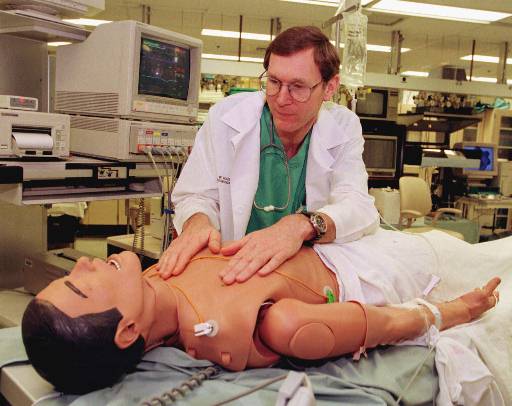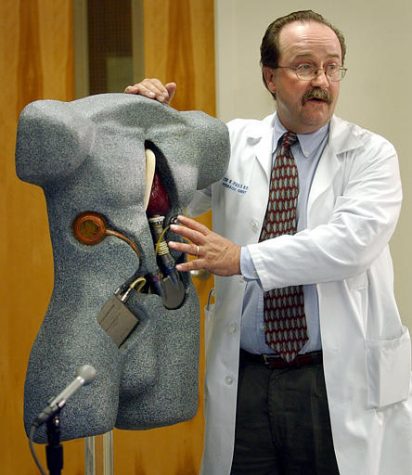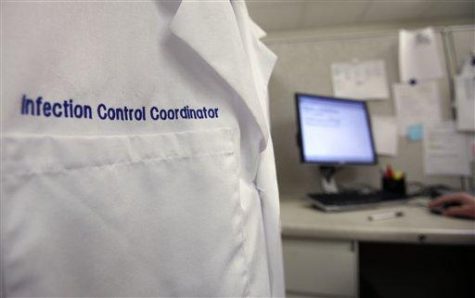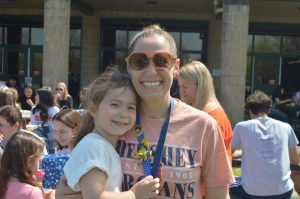Doctors lead hectic lives by saving lives

ADVANCE FOR SUNDAY JUNE 13–Dr. W. Bosseau Murray, director of the Simulation, Development and Cognitive Science Center at the Milton S. Hershey Penn State’s College of Medicine, displays a computerized dummy that simulates breathing and pulse in the Hershey, Pa. Medical Center Monday, June 7, 1999. Doctors, nurses, medical students and anesthesiologists use the dummy to learn how to deal with medical traumas without endangering patients.(AP Photo/Paul Vathis)
October 6, 2016
The alarm clock rings, signaling 5am. Before the birds start chirping or the kids start stirring, the doctor is heading to work.
Dr. Lisa Sinz, anesthesiologist at the Penn State Hershey Medical Center, is one of the many doctors waking up at such an hour, considering that The Hershey Medical Center offers care from six institutes. Providing help to more than 28,000 patients yearly, the Hershey Medical Center is one of the leading hospitals for teaching and researching in the U.S., according to the Penn State Hershey Medical Center. According to Sinz, physicians make sacrifices to be where they are, but it is often worth it. Many of the doctors live a hectic life; but what, truly, is the life of a doctor like?
Doctors specialize in different areas, and depending on their area of work, experience different schedules and daily lives. However, one thing often similar between physicians is the lifestyle they lead.
The life of Sinz, specifically, consists of waking up at approximately 5am and being at the operating room by 6:00 or 6:30am in order to set up for the first patient’s surgery by 7:30.
Sinz is a also a
, so she manages the patients when they are having a surgery. She administers medicine to make a patient unconscious, manages a patient’s consciousness, pain, movement, and other characteristics while they are in surgery.
Sinz cares for the clinically ill, such as people who need operations. Patients who are infected, possibly from heart/liver failure, a trauma patient who is bleeding to death, or someone who is in a fatal physical state are patients who she often treats. She also works in the intensive care unit (ICU) with dangerously ill patients.
However, like all doctors, she wasn’t born an anesthesiologist.
Sinz graduated from medical school in 1991, followed by a residency for four years. After that, she did a fellowship in critical care medicine for one year.
Following her fellowship, she participated in a year of research on traumatic brain injuries. She finished training in 1997, then began working in academic practice. She has always been involved in teaching and research.
In 2004, she joined the staff of the Penn State Hershey Medical Center as one of their many anesthesiologists.
On a typical day, the amount of patients she treats will vary. During a tough surgery, a single patient could take her 12-16 hours. If she’s working in the ICU, she might be in charge of a team who is helping 15 patients. Some anesthesiologists work with out-patients, people who will not need to stay the night in the hospital. Those are patients who might need simple procedures, such as 10 to 20 kids who are getting ear tubes, which is a very quick operation.
Whenever someone is having surgery, there is always someone who is qualified in anesthesiology with them – never a trainee, nurse, or otherwise. They do leave patients with a nurse or someone similar, but Sinz is always supervising them.
Sinz is there for the key parts of a case – when the patient is going to sleep, waking up, or anything in between, but she might not be in the room.
For more fast-paced operations, like a liver transplant, she is in the room for the whole time; there are too many things happening for her to be absent.
Anesthesiologists can supervise up to four nurses who are fully trained and then be present for the key points of the procedure and for anything that goes wrong. In the ICU, Sinz might be directing a whole team to take care of many injured patients.
Sinz’s most difficult procedures are when patients are having surgery on their vital organs, such as the heart or liver. Procedures are difficult when a patient is very sick, old, or young, she explained.
Patients who have been severely injured can be difficult to operate on as well. The doctors try to keep them alive while figuring out what injuries are present.
Unfortunately, surgeries can go wrong. However, anesthesiology has improved greatly over the past 40-50 years according to Sinz. The improvements have allowed doctors to work on sicker patients, and the rate of death or other severe complications has decreased.
One necessary human need is food. Unfortunately, because of doctors’ constantly-changing schedules, it can be hard find a break to eat. The operating room starts and keeps going, and there is no pause for meals.
Since surgeries use a team approach, a doctor can go in and take over, giving another doctor a lunch break. However, this privilege doesn’t apply to Sinz because she doesn’t have someone who can release her.

Dr. Walter E. Pae Jr., uses a life-sized model to explain the operation of the Arrow LionHeart heart-assist device Tuesday, June 24, 2003, during a news conference at Penn State’s Milton S. Hershey Medical Center in Hershey, Pa. Gayle Snider, 35, went back to his York, Pa., home Monday, less than six weeks after he was implanted with the Arrow LionHeart, which can be fully implanted in the body without any cords or tubes passing through the skin. (AP Photo/Carolyn Kaster)
On days when she does eat, the time is really variable. Sometimes she doesn’t eat until she gets home. Breaks happen when everything is going smoothly, but if things need attention, she prioritizes that.
Most days, Sinz is quite busy. She might get a short break, but she always has to be ready to do something.
She’s usually working two rooms at a time, so there could be an emergency in both rooms at once, but they have a whole team, so there’s always someone who can help out. At night, there are always two anesthesiologists in the hospital with the patients for emergency, working the operating room, and there are many doctors on call while at home.
Sinz said, “At Hershey, you’re never gonna be… left without an anesthesiologist around because we have a really robust call system.”
Due to long hours of work, one issue that the doctors and trainees are faced with is fatigue. The residents and trainees all have a plan in place where they can get a break, a nap, or go home in times of fatigue.
If a doctor, such as Sinz, is getting tired, she must be proactive in getting help from her colleagues.
“The faculty… we would have to basically take care of ourselves. We have to recognize that we’re getting tired…,” Sinz said.
Physicians don’t have shifts; they have a schedule. Overnight calls are from 6pm to 7am the next morning.
During the regular day, calls last as long as doctors or other healthcare personnel are needed. A short day may be from 6am to 1pm, according to Sinz.
Staying until 8 or 9pm would not be uncommon, though. Most shifts are 10-12 hours. Because of the necessity of a hospital, many doctors must work on holidays as well.
Doctors at the Hershey Medical Center only need to work two of the six major holidays each year. The six holidays include Memorial Day, the 4th of July, Labor Day, Thanksgiving, Christmas, and New Years.
Despite the heavy hours, Sinz said that she really loves her job. It’s hard but rewarding, and Sinz believes personal satisfaction comes with it. She thinks the love she has for the job is worth the commitment being a doctor requires.
Sinz believes burnout will occur if one doesn’t truly love her or his job in medicine.
“I would not recommend anybody go into medicine unless you have a passion for it because if you do it for any other reason than that you love it, you’re gonna… be really disappointed,” she stated.
One thing that she does not like about her job is the massive amount of computer work the physicians are required to fill out. The system changed from paperwork to computer work years ago, and now the workload is much bigger.

The computers are not adapting to doctors; doctors must adapt to the computers. They have to write in data as codes into the computer to answer the questions the computer is asking. According to Sinz, doctors used to spend 80% of time on patients and 20% on paperwork, but now it’s more 50/50.
Despite that, Sinz still enjoys her job extensively. She believes that if someone wants to train to be a doctor to see if they like it, she/he should gain some experience with ill people.
“If you really like taking care of people and seeing people…, and you don’t get frustrated too easily, then… it [medicine] could be really good,” Sinz commented.
According to Sinz, an appreciation for people and love of giving advice is needed to enjoy the practice of medicine.
“You also need to do really well in medical school,” Sinz said. A lot of hours of work are required even before you get to become a doctor.
However, the stressful times seem to be worth the love and self-fulfillment that the job brings, according to Sinz.
She added, “You go to work, and you feel like you made a difference.”






